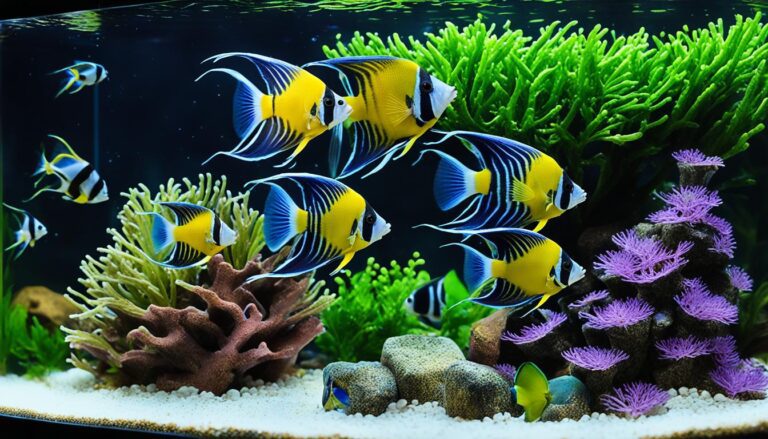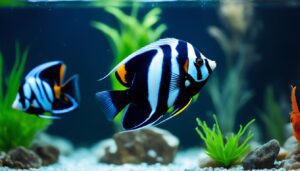Welcome to the world of freshwater aquarium fish, where the beautiful angelfish shines. As an expert, I’m excited to share my knowledge on angelfish care. These fish are loved for their elegant fins and friendly nature. They became popular in America in 1921, starting a trend that lasts to this day.
There are three main types of angelfish, each unique and charming in their own way. From Pterophyllum scalare to Pterophyllum altum, and the rare Pterophyllum leopoldi. These fish from South America can live up to 10 to 15 years with the right care. This shows how well they adapt and how dedicated fish owners are to their needs.
Angelfish breeding is both a challenge and a joy. With the perfect setup, they can show off their breeding behaviors, leading to many fry. As we look at each angelfish type and their care, I hope to help create a great home for these amazing fish.
Whether you’re new or experienced in fish keeping, angelfish ownership is rewarding. They bring peace to freshwater tanks, making them a top choice for fish lovers. Let’s explore how to care for these fish and keep them happy for many years.
Angel Fish Origins & Habitat

Exploring the origins and habitats of types of angelfish shows how they evolved and adapted. Freshwater and marine angelfish give us a peek into their survival skills.
Origin of Pterophyllum Species
The Pterophyllum genus stands out in the Cichlidae family for its unique beauty and body shapes. These freshwater angelfish come from South America’s vast rivers like the Amazon and Orinoco. They include P. scalare, P. altum, and P. leopoldi, with P. scalare being popular in aquariums for its easy care.
Their Natural Habitat
The angelfish habitat is full of diversity and complexity. Freshwater angelfish live in waters that are slightly acidic to neutral. They find shelter and breeding spots in dense vegetation and slow waters. This helps them avoid predators and find food and places to lay eggs.
Marine angelfish live in tropical oceans with coral reefs. This shows how they have evolved differently from freshwater ones. Here’s a table that shows the main differences between freshwater and marine angelfish:
Feature |
Freshwater Angelfish |
Marine Angelfish |
|---|---|---|
Family |
Cichlidae |
Pomacanthidae |
Typical Habitat |
Slow-moving freshwater rivers |
Warm, shallow coral reefs |
Species Count |
3 |
Approximately 85 |
Common Diseases |
Ich, Fin Rot, Swim Bladder Disease |
Similar marine-specific ailments |
Reproduction |
Forms monogamous pairs, lays 100-1200 eggs |
Varies by species, some capable of gender change |
Lifespan (in captivity) |
Up to 12 years |
Varies, up to 15 years for queen angelfish |
Looking into the different angelfish habitats shows their adaptability and strength. Whether in rivers or coral reefs, their study and protection are key for keeping our waters diverse and healthy.
Different Types of Angelfishes

I’ve always been drawn to the world of angelfish varieties. The types of angelfish in our freshwater aquarium fish collections show years of careful breeding. They offer a wide range of colors and patterns. The common silver, zebra, and koi angelfishes are especially popular for their unique looks and charm.
Each angelfish species adds its own beauty to the aquarium. These angelfish varieties vary in color, size, and lifespan. This variety makes them appealing to fish lovers. Let’s explore some key stats about their sizes and lifespans:
Angelfish Type |
Maximum Length |
Average Lifespan |
|---|---|---|
Common Angelfish |
6 inches |
5-10 years |
Silver Angelfish |
8 inches |
10-15 years |
Marble Angelfish |
6 inches |
5-10 years |
Gold Marble Angelfish |
6 inches |
5-10 years |
Zebra Angelfish |
6 inches |
5-10 years |
Koi Angelfish |
6 inches |
5-10 years |
Pearlscale Angelfish |
6 inches |
5-10 years |
The different types of angelfish not only make your tank look better but also offer a challenge for those who care for them. If you’re starting a new tank or want to add something special to your current setup, consider these angelfish varieties. They can make your aquarium experience even more rewarding.
1. Zebra Angelfish

The zebra angelfish is a stunning fish for any freshwater aquarium. Its stripes add a unique look to the tank. They are a favorite among freshwater aquarium fish owners. To keep them healthy and colorful, proper care is essential.
Characteristic |
Detail |
|---|---|
Supplied Size |
1-2 inches / 3-5 cm |
Maximum Size |
6 inches / 15 cm |
Ideal Number Together |
2 or more |
Ideal pH Range |
6.0–7.5 |
Water Hardness |
4-12 dGH |
Ideal Temperature |
23–28°C |
Life Span |
10-12 years |
Dietary Requirements |
Omnivore (flake, granules, occasional live/frozen foods) |
Behavioral Traits |
Generally peaceful, day-active, moderate parental care |
Minimum Tank Size |
125 gallons, 12+ inches wide |
To care for zebra angelfish, focus on their environment and social needs. Keep the water right to avoid stress. They are less aggressive than some other fish, making them good for community tanks. Their looks and behaviors make them a great choice for those into angelfish care.
2. Koi Angelfish
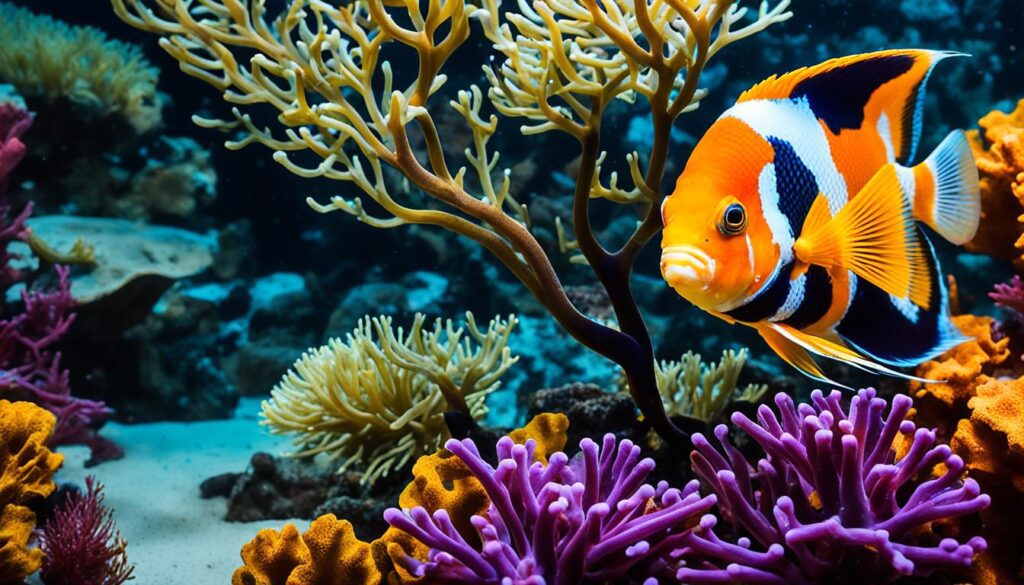
The koi angelfish has striking orange and white colors, looking like traditional koi fish. I focused on creating a tank that looks good and meets their needs for health and long life.
Setting up a angelfish tank for koi angelfish means thinking about their needs. They do well in tanks that feel like their natural home, with good water quality and lots of plants. Here’s how I set up my tank with important fish care tips.
Feature |
Details |
|---|---|
Tank Size |
Minimum of 55 gallons for school of four |
Water Temperature |
76 to 80 degrees Fahrenheit |
PH Level |
6.8 – 7.8 |
Filtration |
Low-flow sponge filter |
Lighting |
Moderate, to replicate shaded environments |
Plants and Decor |
Heavily planted with broad leaves and driftwood |
Following these guidelines helps koi angelfish thrive and makes your aquarium look great. Taking good care of them lets you enjoy their beauty. The koi angelfish looks best in a clean, well-designed tank that feels like their natural home.
3. Silver Angelfish
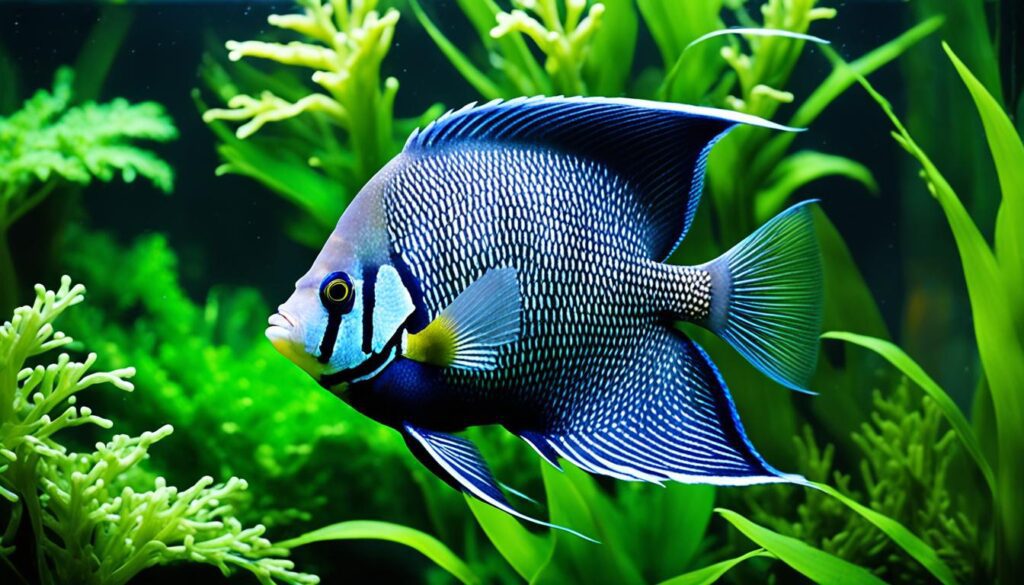
The Silver Angelfish is not just beautiful to look at. It also has a complex genetic makeup. Its shimmering silver body with dark stripes shows its wild roots. It’s a great choice for beginners in the aquarium hobby.
Knowing how long an angelfish lives is key before adding one to your tank. They can live for 10-12 years with the right care. This makes them a great pick for those ready to commit to aquarium care for a long time.
Angelfish breeding is quite special for the silver angelfish. It requires a good understanding of their genetics. With over 25,920 possible genotypes, each breeding cycle can result in unique offspring. This keeps the species diverse and strong.
Category |
Details |
|---|---|
Total views on silver angelfish discussion |
43,000 |
Tank size commonly discussed |
65 gallons (36L x 18D x 24H) |
Typical fish size in tank |
Juveniles grow up to 6 inches |
Longevity of related Silver Dollar fish |
27 years |
Recommended diet tip |
Feed Silver Dollars romaine lettuce weekly |
Angelfish care requires knowledge and preparation. From tank size to diet, it’s important to be ready. If you’re drawn to their genetic complexity or peaceful beauty, these fish can add elegance to your home.
4. Blacklace Angelfish
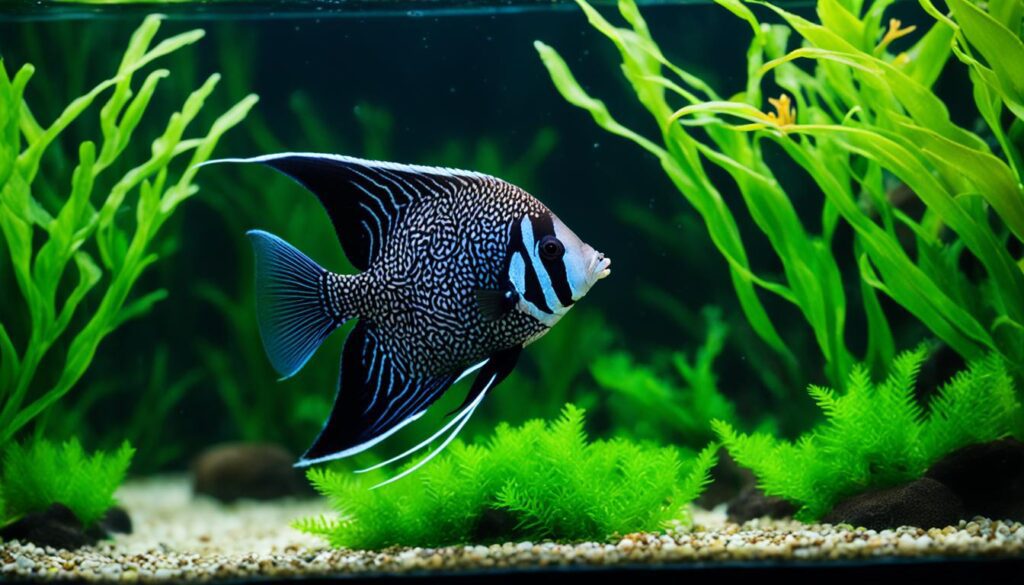
The black lace angelfish is a standout in the world of freshwater aquarium fish. Its intricate patterns make it a visual treat. It’s also a great choice for those who want to add elegance to their tanks. Here are some tips on angelfish care for this unique fish.
These fish have striking silver and deep black markings that look like lace. This makes your aquarium look beautiful and peaceful. They are semi-aggressive, so they do well with other fish that are about the same size and temperament.
For anyone thinking of getting or already owning black lace angelfish, knowing how to care for them is key. Here’s a quick guide on angelfish care for these fish:
- Tank Size: Start with a 30-gallon tank for young groups to give them enough room.
- Water Conditions: Keep the water at 76-86°F and pH 6.0-7.5. Change the water weekly to keep Nitrates below 30 ppm.
- Feeding: Feed them a mix of high-quality dry, fresh, or frozen foods to keep them healthy.
It’s important to adapt your freshwater aquarium and care to fit the black lace angelfish’s needs. For example, introducing them to your tank slowly helps them adjust and prevents stress.
Aspect |
Detail |
|---|---|
Acclimation Time |
Introduce the fish slowly over several hours using drip systems to match the tank’s water conditions. |
Ammonia Management |
Use ammonia neutralizers during setup and check levels often to avoid toxicity. |
Feeding Post-Acclimation |
Start with small amounts of food after they settle to avoid digestive problems. |
Adding a black lace angelfish to your aquarium is more than just basic care. It means understanding their unique needs and behaviors. With this knowledge, your black lace angelfish will not just survive but flourish, bringing elegance and interest to your tank.
5. Golden Angelfish
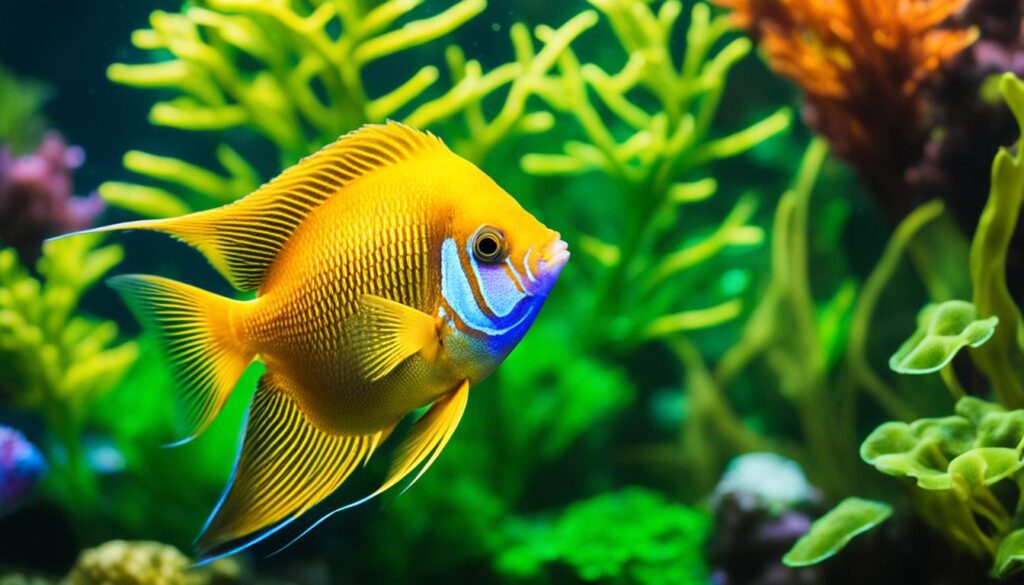
The golden angelfish is loved by many for its bright, shining color. They light up any tank with their beauty. To keep them looking great, it’s important to know what they need for food and care.
My first time seeing a golden angelfish was amazing. Their gold scales shone even in soft light. These fish come from a special mix of genes, showing the beauty of genetic diversity. It’s key to understand their diet to care for them well.
Golden angelfish eat a mix of foods full of nutrients. They like high-quality dry flakes, angelfish granules, and sometimes live or frozen foods. Here are tips for feeding them well:
- Alternate between protein-rich food and greens for balanced nutrition.
- Feed them small amounts often to avoid overeating and waste.
- Watch how much they eat to adjust their food if needed.
Keeping their tank right is also vital for their health and color. A stable, clean tank helps them stay healthy and bright. Here’s what their tank should be like:
Parameter |
Ideal Condition |
|---|---|
Temperature |
78-84°F |
pH Level |
6.5-7.5 |
Water Hardness |
3-8 dKH |
Tank Size |
At least 30 gallons |
It’s important to check the water often and fix any issues. Joining a group of other angelfish lovers can also help a lot. They share tips and support, making your fish-keeping journey better.
Whether you’re an expert or new to fish care, the golden angelfish is a rewarding choice. Follow these tips, and you’ll enjoy watching your golden angelfish flourish.
6. Blushing Angelfish
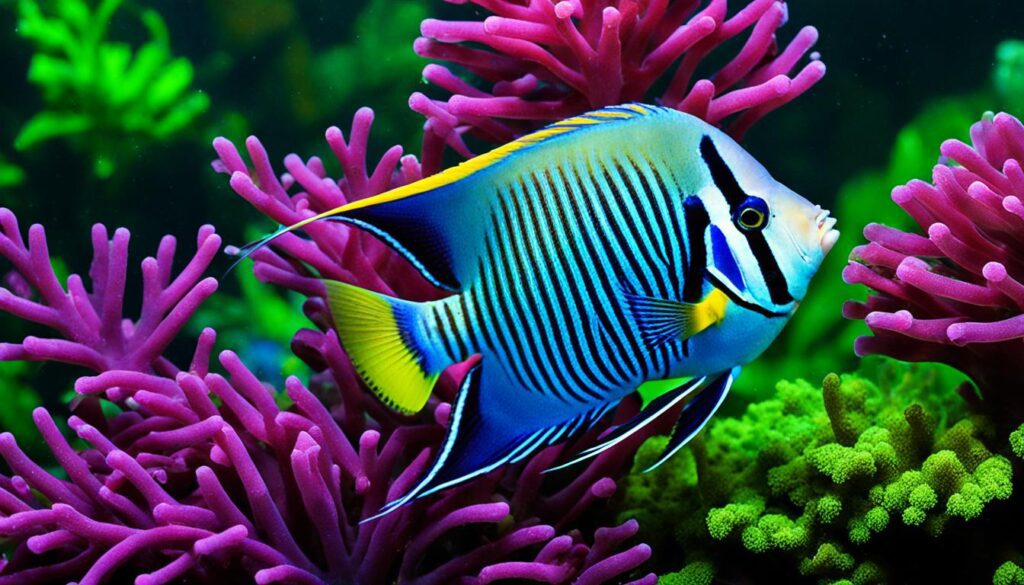
The blushing angelfish stands out in freshwater aquariums with its unique look and calm nature. It’s known for its almost transparent skin and a delicate pink color. This makes them seem like they’re blushing, adding a peaceful yet interesting touch to any tank.
These angelfish can grow up to 6 inches long, making them a medium-sized fish. They do best in water that’s between 75-82 degrees Fahrenheit. Keeping an eye on the temperature is key to their health.
When it comes to breeding, blushing angelfish are very peaceful. But, they need enough space to be happy and breed well. This space helps reduce stress, which is important for breeding success.
Characteristic |
Requirement |
Details |
|---|---|---|
Minimum Tank Size |
30 gallons |
Provides ample space for swimming and health |
Water Temperature |
75-82 °F |
Ideal range for maintaining health |
Comfort in Community |
Peaceful with space |
Avoids stress and promotes healthy breeding |
Size at Maturity |
Up to 6 inches |
Requires space as they grow |
For those into freshwater aquarium fish or angelfish breeding, the blushing angelfish is a great choice. They bring a calming vibe and can breed well. Creating the best environment for them will improve their health and your breeding success. Adding these peaceful fish to your tank is a wonderful idea for any aquarist looking to diversify their collection.
7. Marble Angelfish
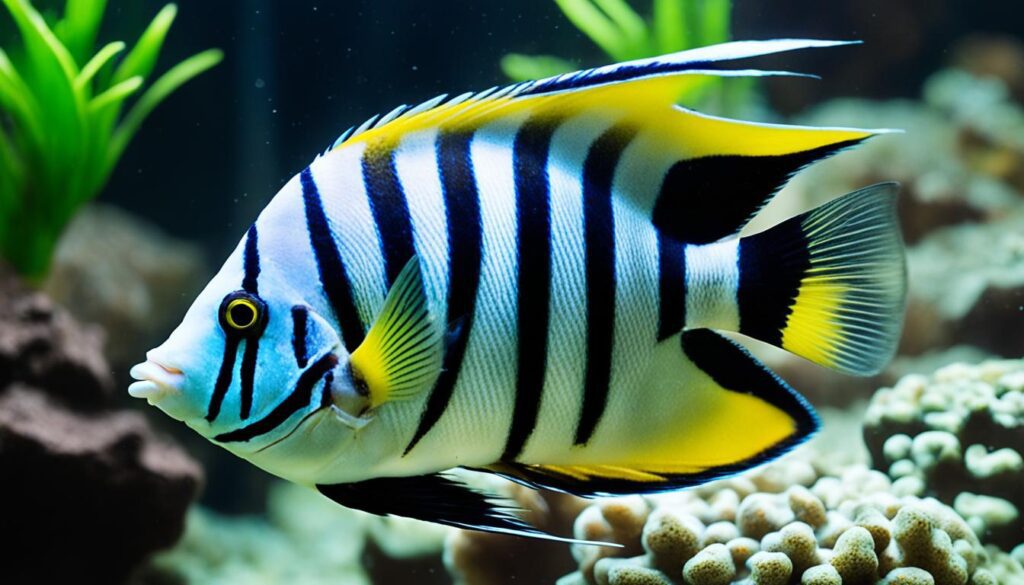
The marble angelfish is a standout in the angelfish family. It’s known for its marble-like color patterns. These fish have a mix of black, white, and sometimes golden colors. They add a stunning look to any angelfish tank setup.
When looking after angelfish, remember the marble angelfish’s needs. They can grow up to 6 inches long and need a tank of at least 30 gallons. They like water that’s warm, between 76ºF and 86ºF, and slightly acidic, with a pH of 6.0 to 7.4.
Marble angelfish do well in a tank with other fish of similar size. This prevents fighting and bullying. As they get older, they might find a mate and become a bit territorial. Keep this in mind when setting up your angelfish tank.
These fish eat both plants and animals. In the wild, they eat insect larvae and small fish. In your tank, feed them a mix of flakes, frozen or live brine shrimp, and bloodworms. This diet keeps them healthy and colorful.
If you want to breed marble angelfish, you’ll need to adjust the tank’s water. Aim for a pH of about 6.5 and temperatures between 80ºF and 85ºF. The parents will pick a spot for their eggs, which hatch in two days. Feed the fry brine shrimp nauplii a week after they hatch to help them grow.
Though caring for marble angelfish can be challenging, the reward is worth it. Watching them swim with their beautiful marbled patterns is mesmerizing. Keeping a tank of these fish is both beautiful and fulfilling, showing your skill in angelfish care.
8. Altum Angelfish
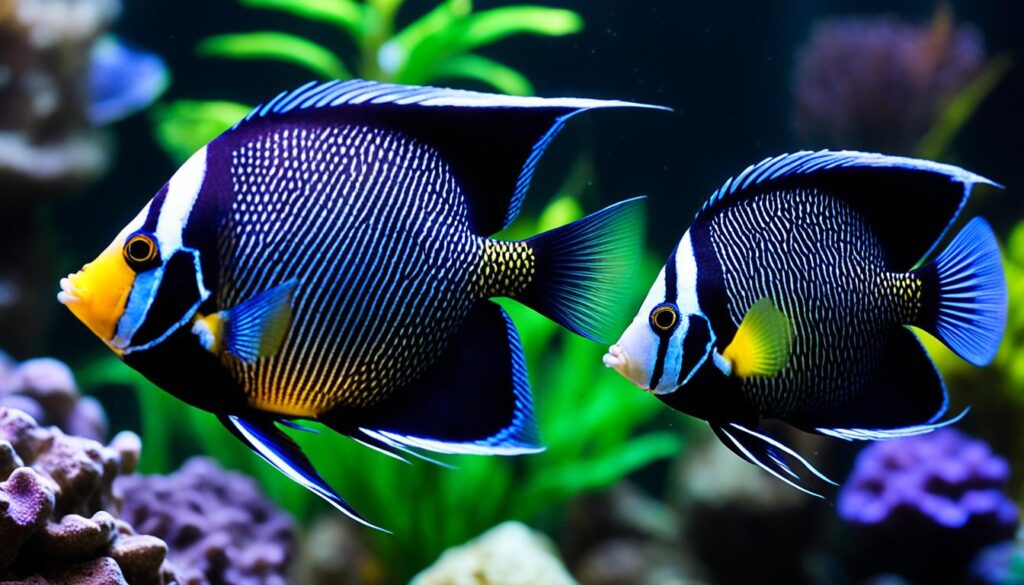
The altum angelfish is a standout among types of angelfish for its size and beauty. It can grow up to 7 inches long and 10-13 inches tall. This makes it a majestic sight in the aquarium world.
I started my journey with altum angelfish by learning about their angelfish lifespan, which is 8 to 12 years with proper care. Keeping their tank clean and feeding them well is key to their health.
- Pricing: Altum angelfish cost between $5 to over $20, based on their size and color rarity.
- Spawning: Altum angelfish can lay up to 1000 eggs, resulting in 300 to 600 fry, showing their high fertility.
- Water Preferences: They need consistent water conditions. Ideal temperatures are 78-86°F, and they prefer a pH of 6.0 to 8.0, but slightly acidic is best.
These fish are semi-aggressive and need careful tank mates and setup, especially when breeding. Keeping their tank clean and checking the water regularly is crucial to prevent health issues like cottony growths, which can be treated with Furan 2 and Kanaplex.
Keeping altum angelfish has been a fascinating experience. It requires a lot of work, from regular water changes to watching for health problems. This dedication helps them live longer and adds beauty to the aquarium.
Altum angelfish are truly captivating. Their rarity and beauty make them a prized addition to any aquarium. For those who love angelfish, adding altum angels can be a rewarding experience. It comes with challenges but also brings great joy.
Angelfish Lifespan
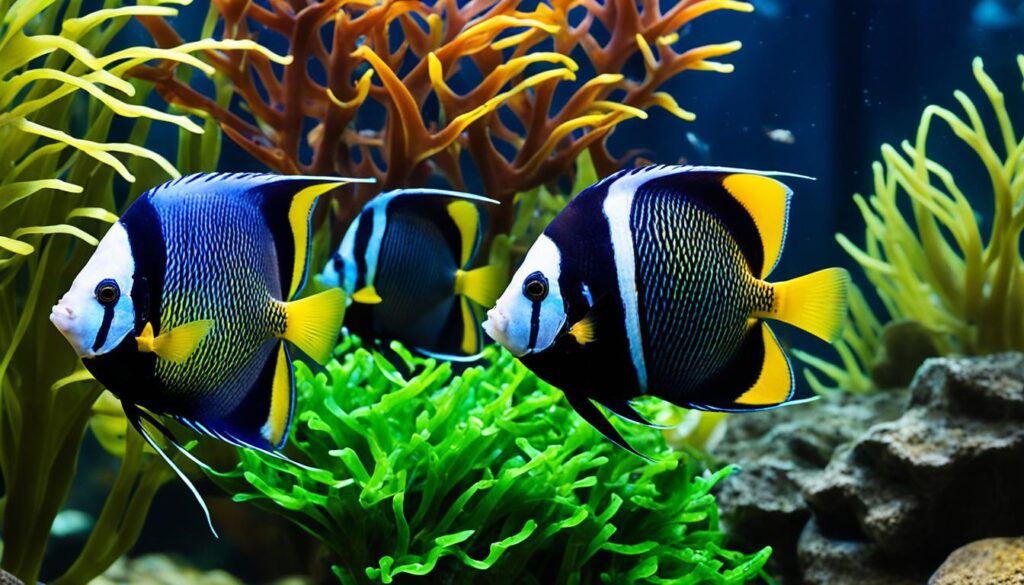
Understanding the angelfish lifespan and what affects it is key to keeping these beautiful freshwater aquarium fish happy. Angelfish can live from 10 to 15 years in the right conditions. But, many things can change their health and how long they live.
Factors Influencing Longevity in Aquatic Environments
The environment is very important for angelfish. They do best in aquariums that feel like their home. The tank’s size, water quality, and who they live with affect their health. They like tall tanks with lots of room to swim up and down.
Keeping the water right is also key. They need temperatures between 76 and 82 degrees Fahrenheit and pH levels from 6.5 to 7.5.
Tips to Improve Lifespan of an Angelfish
Good fish care tips can help your angelfish live longer. Feeding them a mix of live, freeze-dried, and prepared foods is important. Live food helps them act naturally and gives them the nutrients they need.
Keeping their home stable and low stress is also crucial. Check the water often and adjust it as needed. This keeps your angelfish happy and healthy.
Adding plants and hiding spots to the tank helps them feel at home. This reduces stress and lets them behave naturally. Here’s some important info on angelfish care:
Characteristic |
Requirement or Fact |
|---|---|
Average Lifespan |
10-15 years |
Optimal Water Temperature |
76-82°F |
pH Levels |
6.5-7.5 |
Water Hardness (GH) |
5-13 degrees |
Recommended Tank Size |
At least 20 gallons, 55 gallons for multiple |
Diet |
Live, freeze-dried, and formulated foods |
Size at Maturity |
Up to 12 inches (rarely over 8 inches in captivity) |
Following these tips can make your angelfish live longer and happier in your aquarium. With careful and informed care, they can be a beloved part of your aquatic world for years.
Ideal Tank Setup
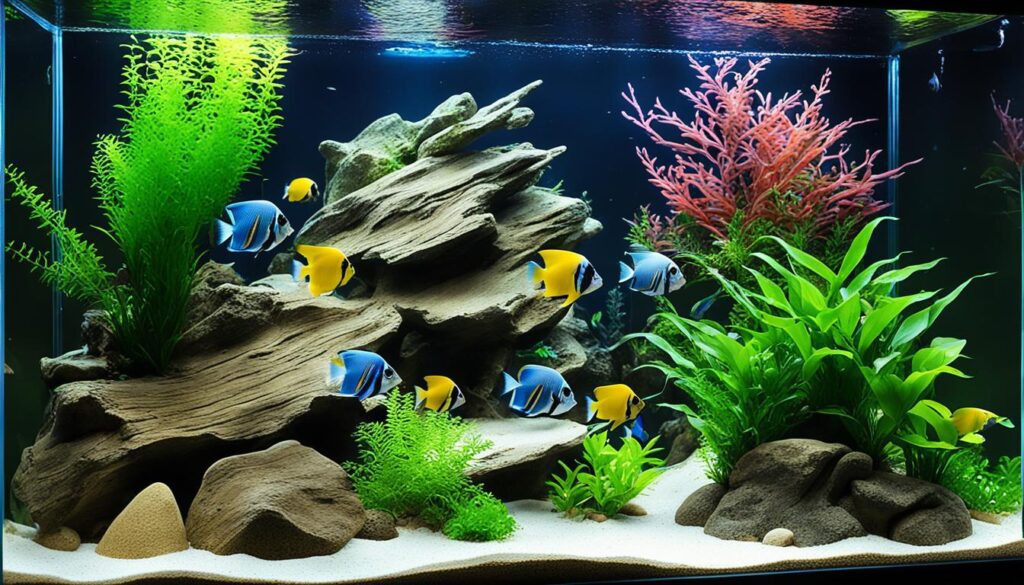
Setting up the perfect angelfish tank requires understanding these beautiful fish well. Let’s explore how to make a peaceful and supportive space for them. This will help keep them healthy and colorful in your aquarium.
Tank Size & Shape
Size and shape matter a lot in caring for angelfish. A single angelfish needs at least a 30-gallon tank, as they can grow up to 10 inches tall. For more angelfish or breeding pairs, go for a bigger tank, around 48 inches long. This size helps avoid fights and gives them enough room to swim. A tall tank is best since they like to swim up and down.
Water Requirements
Angelfish do well in water that’s stable, like their Amazon home. Keep the water temperature between 74 to 84 degrees Fahrenheit and the pH between 6.8 to 7.8. It’s important to check and adjust the water often to keep it soft and acidic, which is good for their health.
Heat & Lighting
Heating and lighting are key for your tank’s look and your fish’s health. Use a good aquarium heater to keep the water at the right temperature. The lighting should be moderate to show off the angelfish’s colors and help plants grow. A timer can help keep the light on a natural cycle, which is good for both fish and plants.
Importance of Low-Flow Filtration and Stable Chemistry
Angelfish like slow-moving water with low-flow filters, just like the calm rivers and floodplains of the Amazon. This type of system stops strong currents that can stress them out. Also, keeping the water chemistry stable with regular tests and upkeep helps support a healthy diet for the angelfish by keeping the tank’s ecosystem balanced.
In conclusion, making the right angelfish tank is more than just filling a tank with water. It’s about creating a home that meets their special needs, from the tank size and water quality to the right filtration and lighting. This way, you’ll not only keep your angelfish healthy and happy but also enjoy their beauty in your home.
Tank Mates for Angelfish
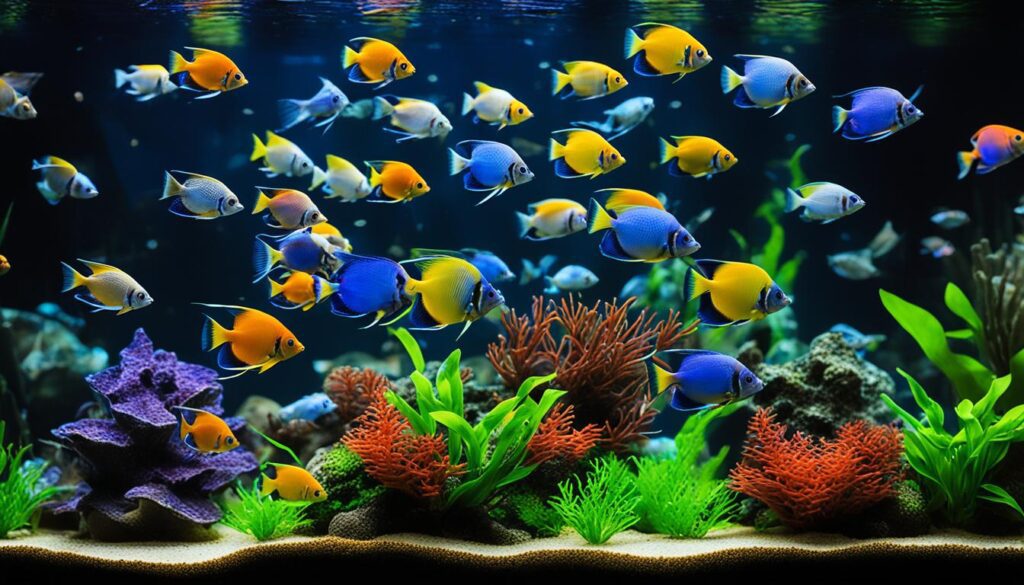
Choosing the right tank mates for angelfish is key to a peaceful aquarium. Angelfish are calm but can be semi-aggressive, especially when breeding. They do best with certain fish that match their peaceful nature. Let’s explore the best friends for your angelfish and how to build a happy aquarium community.
Forums suggest that big tetras like the Black Skirt Tetra and bottom fish like the Corydoras Catfish are great with angelfish. These fish live well together and match the angelfish’s calm nature. Other good choices include the Pencilfish and the Bolivian Ram, which are peaceful and add beauty to your tank.
Species |
Compatibility with Angelfish |
Remarks |
|---|---|---|
Black Skirt Tetra |
High |
Peaceful species; minimal fin nipping |
High |
Excellent bottom dwellers |
|
Pencilfish |
Moderate |
Needs similar water conditions |
Bolivian Ram |
High |
Peaceful cichlid, good for community tanks |
Bristlenose Pleco |
High |
Helps keep the tank clean |
When making a community aquarium, avoid fast fish or fin nippers that might stress the angelfish. Keep the water stable with temperatures between 78-84 degrees Fahrenheit, as advised by aquarium forums. A stable environment reduces stress and supports a healthy ecosystem.
Angelfish might sometimes be aggressive towards other fish. To manage this, watch the fish closely and make sure the tank is big enough (at least 40 gallons) for everyone. The aim is to let your angelfish and their friends live well together.
Angelfish Diet
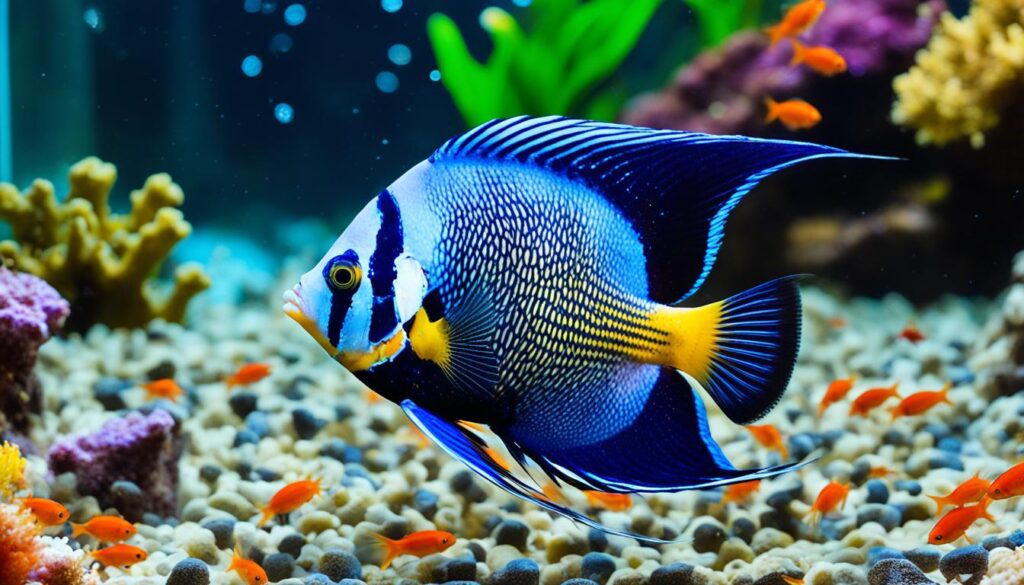
Exploring angelfish care shows us how important their diet is for their health and color. These fish are not just pretty; they have interesting eating habits. I’ll talk about the mix of commercial and live foods and give tips to avoid overfeeding.
Commercial Foods Versus Live Treats
Angelfish eat a bit of everything. I’ve found that mixing high-quality flakes and pellets with live foods like bloodworms and brine shrimp works well. This mix gives them the nutrients they need and makes them act naturally. It’s key to use clean, safe live food to avoid health problems. Adding live treats often makes their meals more interesting.
How to Prevent Overfeeding and Maintain Water Quality
Feeding angelfish too much can harm their health and the tank. Here’s how to feed them right: give them just enough food for them to eat in a few minutes, two to three times a day. Watch how fast they eat to adjust the food amount. Keeping the tank clean is also crucial, with weekly filter cleanings and monthly water changes.
Diet Component |
Description |
Frequency |
|---|---|---|
Commercial Foods (Flakes, Pellets) |
Basic diet providing necessary nutrients |
Daily |
Live Foods (e.g., Bloodworms, Brine Shrimp) |
Supplements the main diet, encourages natural foraging behavior |
2-3 times per week |
Water Changes |
Maintain water quality and reduce risk of disease |
10-25% monthly |
Feeding your angelfish a balanced diet is key to their care. Watching how much they eat and keeping their home clean keeps them healthy and colorful. A well-fed angelfish is a happy one!
Angelfish Breeding
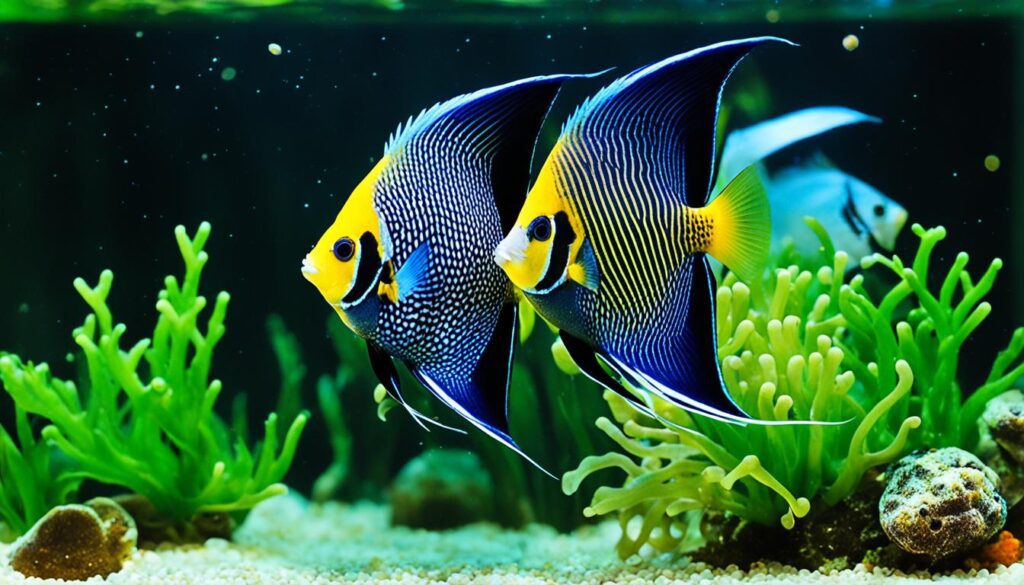
Breeding angelfish is a fascinating journey. It starts with understanding angelfish spawning and the right conditions for fry care. Today, I’ll share key insights into recognizing when and how angelfish breed. I’ll also cover the best practices for a healthy environment for the fry.
Distinguishing Male from Female Angelfish
Figuring out the sex of angelfish is tricky because the differences are subtle. However, during breeding season, males show slight enlargements around the breeding tube. Females have rounder, larger breeding tubes used for laying eggs. Experienced breeders can spot these differences by watching the angelfish’s behavior and physical traits during spawning.
Spawning & Fry Care
Angelfish usually spawn on vertical surfaces like aquarium glass or broad leaves. Females lay rows of tiny, pearly eggs. The males then fertilize these eggs by swimming over them. It’s important to provide the right environment for successful spawning. The water temperature should be between 78° to 86°F, and the pH level should be between 6.5 and 6.9.
After about 60 hours, the eggs hatch, and the angelfish fry start feeding on their yolk sac. They switch to live food like freshly hatched brine shrimp about a week later. Fry care is crucial; they need clean water with frequent changes and precise temperature control. It’s important to keep the tank clean to prevent water spoilage and keep the fry healthy.
Here are some key statistics for successful angelfish breeding:
Aspect |
Recommendation |
|---|---|
Breeding Success Rate |
90% of eggs become sellable juveniles |
Ideal Tank Size for Angelfish Spawning |
At least 20 gallons, preferable 29 gallons for comfort |
Water Changes for Spawning Encouragement |
75% change to stimulate breeding |
Feeding Frequency for Fry |
Four to five times daily with live food |
Water Temperature |
Maintain between 80°F and 85°F (27-29°C) |
It’s crucial to keep an eye on these conditions to ensure the health and growth of the breeding pair and their fry. Successful angelfish breeding requires understanding and meeting these physical needs. It also needs patience and dedication to the detailed care of angelfish and their fry.
Nurturing for Angelfish
As an aquarist, I love learning about angelfish care. These fish, like P. altum, P. leopoldi, and P. scalare, take great care of their babies. They protect and help their young grow from tiny eggs to strong swimmers.
Caring for the Young: From Egg to Independence
Angelfish lay their eggs on plants or flat surfaces in the tank. Most angelfish in tanks are bred in captivity. I make sure their eggs hatch in the best conditions.
I keep the water warm, between 78°F and 84°F, and the pH balanced. It’s important to keep the water clean, with no Ammonia, Nitrite, or high Nitrate levels. This helps the baby fish grow safely.
Adapting Tank Conditions for Growing Angelfish
As the young angelfish grow, they need more space. A 55-gallon tank is good for five to six young ones. Adding 10 gallons for each extra fish helps prevent fighting.
The water stays warm, between 75°F and 82°F, for their health. They eat a mix of protein and plants to grow strong. Changing the water often keeps their home clean and healthy. This way, each angelfish can live up to 12 years.
